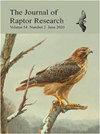Variation in Cooper’s Hawk (Accipiter cooperii) Eggshell Thickness: DDT, Measurement Methods, and Location
IF 1.2
4区 生物学
Q2 ORNITHOLOGY
引用次数: 0
Abstract
We collected Cooper’s Hawk (Accipiter cooperii) eggshells from nests in the Tucson, Arizona, USA, area in the 1990s incidental to other activities and compared them to pre-DDT Cooper’s Hawk eggshells (119 museum specimens from 14 states, 1894–1939) ranging from 0.284–0.402 mm (x̄ = 0.348 mm, SD = 0.0243) and we also compared them to reported thicknesses found in the literature. We found that within-state eggshell thickness varied as did eggshell thickness among states. Of the pre-DDT eggshells measured, those from Arizona, Utah, and Nevada were thinnest and generally eggs from western states (x̄ = 0.339 mm, SD = 0.0184) had significantly thinner eggshells than those for eastern states (x̄ = 0.359 mm, SD = 0.0256). Other published measurements of pre-DDT Cooper’s Hawk eggshells were slightly lower than ours but were generally within the lower range of our measurements, which was expected because of the measuring technique used in earlier studies versus our method. Cooper’s Hawk eggshells that were collected from nests in the Tucson area in the 1990s had a mean thickness of 0.309 mm (SD = 0.0191) and the pre-DDT mean thickness of museum eggshells from Arizona was 0.333 mm (SD = 0.018). Although the Tucson eggshells were significantly thinner than pre-DDT eggshells overall (t = 10.8, df = 100.4, P < 0.001), some individual pre-DDT eggshells and even some means from other regions (e.g., New Hampshire, New York, and Nevada) were similarly thin. Measurements of these pre-DDT eggshells show wide variation and demonstrate the importance of comparing eggs from the same geographical area and having an adequate sample size.库珀鹰(Accipiter cooperii)蛋壳厚度的变化:滴滴涕、测量方法和地点
20 世纪 90 年代,我们在美国亚利桑那州图森市的巢穴中采集了库珀鹰(Accipiter cooperii)的蛋壳,并将其与滴滴涕使用前的库珀鹰蛋壳(来自 14 个州的 119 个博物馆标本,1894-1939 年)进行了比较,蛋壳厚度为 0.284-0.402 毫米(x̄ = 0.348 毫米,SD = 0.0243),我们还将其与文献中报道的厚度进行了比较。我们发现,各州内部的蛋壳厚度不同,各州之间的蛋壳厚度也不同。在测量的滴滴涕使用前的蛋壳中,来自亚利桑那州、犹他州和内华达州的蛋壳最薄,一般来说,来自西部各州(x̄ = 0.339 mm,SD = 0.0184)的蛋壳明显比东部各州(x̄ = 0.359 mm,SD = 0.0256)的蛋壳薄。其他已发表的对DDT前库珀鹰蛋壳的测量结果比我们的测量结果略低,但一般都在我们的测量结果的较低范围内,这在意料之中,因为早期研究使用的测量技术与我们的方法不同。20世纪90年代在图森地区采集的库珀鹰蛋壳平均厚度为0.309毫米(SD = 0.0191),而亚利桑那州博物馆的DDT前蛋壳平均厚度为0.333毫米(SD = 0.018)。尽管图森的蛋壳整体上明显比DDT前的蛋壳薄(t = 10.8, df = 100.4, P < 0.001),但一些个别的DDT前蛋壳,甚至一些其他地区(如新罕布什尔州、纽约州和内华达州)的平均蛋壳也同样薄。对这些前滴滴涕(DDT)蛋壳的测量结果显示出很大的差异,这说明对来自同一地理区域的蛋进行比较和具有足够样本量的重要性。
本文章由计算机程序翻译,如有差异,请以英文原文为准。
求助全文
约1分钟内获得全文
求助全文
来源期刊

Journal of Raptor Research
生物-鸟类学
CiteScore
2.30
自引率
17.60%
发文量
61
审稿时长
>12 weeks
期刊介绍:
The Journal of Raptor Research (JRR) is an international scientific journal dedicated entirely to the dissemination of information about birds of prey. Established in 1967, JRR has published peer-reviewed research on raptor ecology, behavior, life history, conservation, and techniques. JRR is available quarterly to members in electronic and paper format.
 求助内容:
求助内容: 应助结果提醒方式:
应助结果提醒方式:


